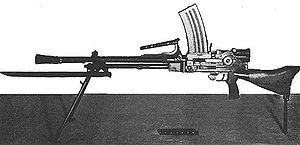| Type 99 light machine gun | |
|---|---|
 Type 99 light machine gun | |
| Type | Light machine gun |
| Place of origin |
|
| Service history | |
| In service | 1939–1945 |
| Used by |
|
| Wars |
Second Sino-Japanese War, World War II, Korean War, Chinese Civil War, Vietnam War |
| Production history | |
| Designer | Kijiro Nambu |
| Designed | 1939 |
| Produced | 1939–1945 |
| Specifications | |
| Mass | 10.4 kg (23 lbs) |
| Length | 1181 mm (46.5 in) |
| Barrel length | 550 mm (21.7 in) |
|
| |
| Cartridge | 7.7×58mm Arisaka |
| Action | Gas-operated |
| Rate of fire | 700 rounds per minute |
| Muzzle velocity | 730 m/s (2,400 ft/s) |
| Feed system | 30 round detachable box magazine |
The Type 99 light machine gun (九九式軽機関銃 Kyūkyū-shiki Kei-kikanjū) was a light machine gun used by the Imperial Japanese Army in World War II.[1]
History and development[]
The Type 96 light machine gun, an improvement over the previous Type 11 light machine gun was introduced into combat service in 1936, and quickly proved to be a versatile weapon to provide covering fire for advancing infantry.[2] Both the Type 11 and Type 96 used the same 6.5x50mm Arisaka cartridges as the Type 38 rifle infantry rifle.[3] The system had the advantage that any squad member could supply ammunition for the light machine gun; however, as the Japanese army was switching from the Type 38 rifle to the Type 99 Rifle which used a 7.7 mm cartridge, it was necessary to develop a new version of the Type 96 light machine gun that would also be able to use this larger caliber.
Design[]
The Type 99 was basically the same design as the Type 96 light machine gun, and had a number of parts in common. However, it dispensed with the oiler and had better primary extraction, increasing reliability over its predecessors. Early models had a mono-pod at the stock and a flash suppressor on the muzzle, which was screwed onto a threaded portion of the gun barrel.[3] A top-mounted curved detachable box magazine held 30 rounds, and the finned gun barrel could be rapidly changed to avoid overheating.
The Type 99 had a blade front sight and a leaf rear sight, with graduations from 200 to 1,500 meters, with a wind adjustment. A 2.5X telescopic sight with a 10 degree field of view could be attached at the right side of the gun.[3] These were often issued to the best marksmen of the unit and occasionally employed like a sniper rifle. A standard infantry bayonet could be attached to the gas block below the barrel, but on the battlefield this feature proved inconsequential due to the weight of the gun and that the blade was largely obstructed by the flash hider when it was fixed on the muzzle.[4]
Combat record[]
The Type 99 came into active service in 1939, and was used side-by-side with the older Type 11 and Type 96, as these models had been produced in large quantities and many front line troops continued to use the Type 38 rifles with their 6.5 mm ammunition. All three weapons remained in service until the end of the war.[5]
Variants[]
A limited production version of the Type 99 was produced for paratroopers. It had a detachable stock and a forward-folding pistol grip. For deployment, the barrel and butt were detached from the gun, the pistol grip and bipod folded, and the entire set packed into a carrying bag.[4]
See also[]
- Mendoza RM2
- Lahti-Saloranta M/26
- FM-24/29
- Furrer M25
- Weibel M/1932
- Bren gun
- Charlton Automatic Rifle
- M1918 BAR
- FG 42
Notes[]
References[]
- Bishop, Chris (eds) (1998). The Encyclopedia of Weapons of World War II. Barnes & Nobel. ISBN 0-7607-1022-8.
- Mayer, S.L. (1984). The Rise and Fall of Imperial Japan. The Military Press. ISBN 0-517-42313-8.
- Morse, D.R. (1996). Japanese Small Arms of WW2; Light Machine Guns Models 11, 96, 99 97 & 92. Firing Pin Enterprizes. ASIN: B000KFVGSU.
- Popenker, Maxim (2008). Machine Gun: The Development of the Machine Gun from the Nineteenth Century to the Present Day. Crowood. ISBN 1-84797-030-3.
- Rottman, Gordon L. (2005). Japanese Infantryman 1937-1945. Osprey Publishing. ISBN 1-84176-818-9.
- US Department of War (1994 reprint). Handbook on Japanese Military Forces, TM-E 30-480 (1945). Louisiana State University Press. ISBN 0-8071-2013-8.
External links[]
- Modern Firearms
- Taki’s Imperial Japanese Army page
- US Technical Manual E 30-480
- Japanese Model 99 MG Tactical and Technical Trends No. 35, U.S. War Department
| Wikimedia Commons has media related to Type 99 LMG. |
| ||||||||||||||||||||||||||||||||||||||||||||||||||||||||
The original article can be found at Type 99 light machine gun and the edit history here.